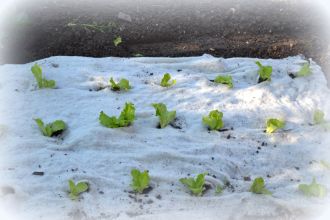How to reduce weed growth and conserve moisture in your beds? How to get rid of pests? What are the benefits of mulching with wool?
An organic wool mulch is very useful for all kinds of vegetables – from early lettuce to endive and radicchio, and especially for tomatoes and peppers, which need constant moisture and a clean environment. It allows less watering, acts as a buffer between the plant and the mud, protects the crop from pests, reduces the passage of red snails, provides a barrier between the beds, makes a decorative finish to the ornamental bed, inhibits and prevents weed growth. It is increasingly used for landscaping parks, ponds and embankments.

Sheep’s wool plays a similar role in the raised garden bed. Are you interested in how to use it?
- Place the wool felt right at the bottom of the bed, then coat the inside of the bed, up to about half a metre below the top. The felt replaces various unnatural internal protective materials such as rubber, foil, etc.
- Loose unwashed sheep’s wool or kemlak (waste wool from production) is placed in the raised garden bed above the brushwood or just below the final layer of fertile soil.
If you have a raised garden bed in a very sunny area, we recommend that you also protect the top of the bed with an organic wool mulch, in which holes are made and plants are planted. The same mulch can be planted two to three times and finally buried in the soil, where it will continue to act as a soil moisture regulator, promoting growth, repelling pests, etc.
There are two thicknesses of sheep’s wool mulch:
- 3 mm thick, which has a lifespan of up to one year and allows double planting (lettuce first, then tomatoes);
- 3-4 mm, which is usually placed with perennial crops and has a lifespan of two to three years. However, if placed in a vegetable garden, it can be stored in the cellar in the autumn and used again in the spring, so it can be used for at least two years or four planting periods.
Wool mulches are never waste, they end up turning into compost, soil fertiliser, etc. They continue to work in the soil for at least three years after they have been buried.
Wool felt can be used as an inner cover (along the inner sides of the planting container) and an outer cover (on top of the trough or bed). However, the greatest benefit will be gained if the wool felt is placed right at the bottom of the trough or pot, where it will regulate moisture and promote growth.
Did you know that organic felt can be an excellent protection in vegetable and fruit crates? Good practice examples from cheesemakers from near and far and from fruit and vegetable crate distributors, who have experienced that felt is at least 20 times more durable than paper, are more than telling.
Marija Srblin, Director of the Soven Company